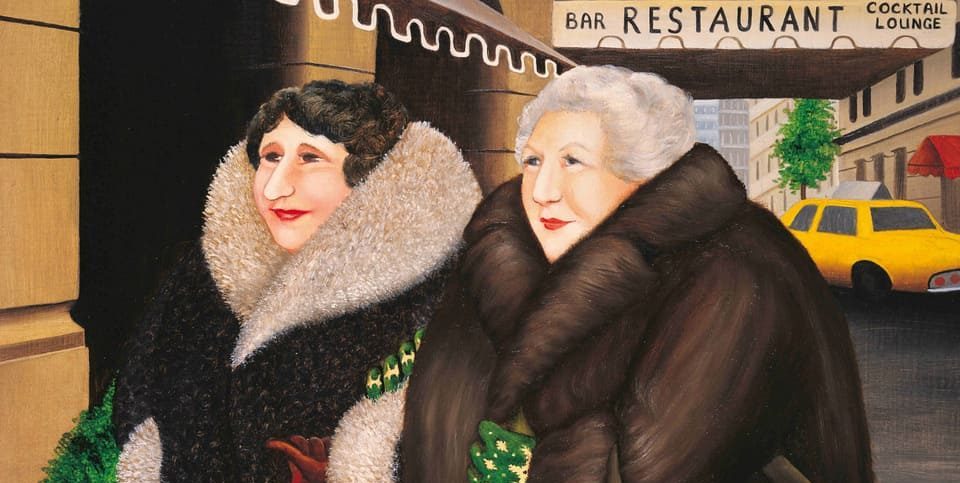If you’ve ever stumbled upon artwork that feels both playful and heartwarming, with scenes that burst with life and humor, chances are you’ve encountered the work of Beryl Cook. A self-taught artist who didn’t pick up a paintbrush until her thirties, Cook’s art became emblematic of British popular culture during the 1980s.
Beryl Cook’s Beginnings
Born in 1926, Beryl Cook left school at 14 and moved to London, working various jobs in pubs, clubs, and even performing as a chorus girl during a summer season. Her formal art education was nonexistent, but that hardly mattered. In fact, her variety of work experiences would deeply influence her art career. Working in lively environments such as pubs and clubs exposed her to social scenes filled with character and humor—elements that would later define her artistic style.
Cook’s time as a chorus girl also gave her an appreciation for performance and theatrics, which can be seen in the exaggerated expressions and joyful energy of her painted figures. The hustle and vibrancy of London life, paired with her interactions with colorful characters from all walks of life, provided a rich tapestry of inspiration for her work.
All of these experiences contributed to her fascination with the unfiltered aspects of human behavior, which she would later capture so brilliantly on canvas.
How Did Beryl Cook Become an Artist?
Cook didn’t discover her love of painting until her thirties, when she and her husband moved to Cornwall. Inspired by the lively characters and social interactions she observed, she began painting through her distinctive lens. It wasn't until she was in her fifties that her work gained significant attention. Her first exhibition in 1975 was a tremendous success, even landing her a cover story in the Sunday Times. Despite her popularity with the public, the art establishment largely dismissed her work, considering it too populist and lacking in seriousness.
Cook's art style was characterized by its vivacity and spirit. Her work featured rounded, exaggerated figures, often depicted in social settings like pubs, nightclubs, or holidays, celebrating life. Her paintings had a cartoonish quality that amplified the comedic aspects of everyday life, while her attention to detail captured the subtleties of social interactions. The vibrancy and expressiveness of her work made it both accessible and instantly recognizable, endearing her to audiences worldwide.
Why Was Beryl Cook a Controversial Artist?
Part of what made Cook’s work so controversial was precisely what made it beloved by so many. Her paintings depicted everyday people enjoying themselves without inhibition—drinking, dancing, shopping, lounging by the pool—presented with warmth and a touch of playfulness. She painted scenes of real life that many saw as lowbrow or unrefined, but the public adored her relatable depictions. Her cheerful yet daring style drew influences from Edward Burra and Stanley Spencer but was uniquely her own.
The art establishment’s dismissal of Cook’s work was not unusual during the mid-to-late 20th century. This was a period heavily influenced by abstract expressionism, conceptual art, and the emergence of minimalism. Artistic prestige was often associated with intellectualism, experimentation, and avant-garde principles. Artists like Mark Rothko, Francis Bacon, and Lucian Freud—who were celebrated for their complex explorations of identity, form, and existential themes—defined the era’s artistic canon.
Cook’s work, by contrast, was rooted in joy and popular appeal. She captured the unpretentious energy of social gatherings and unfiltered human interaction, which many in the art world viewed as unsophisticated and lacking depth. Because her work was widely reproduced on commercial items such as calendars and greeting cards, critics often dismissed it as kitsch rather than serious art. However, this accessibility was precisely what made her art so beloved by the general public.
A Closer Look at Cook’s Most Famous Paintings
Cook’s paintings are instantly recognizable for their bold and colorful depictions of ordinary people. Three of her most famous paintings include:
Striptease, a dynamic painting that captures the bustling energy of a burlesque performance. The audience’s amused expressions likely mirror the viewer’s reaction, highlighting Cook’s ability to create scenes that feel inclusive and celebratory.
Girls’ Night Out, a painting that epitomizes Cook’s talent for conveying joy and camaraderie. The scene shows a group of waitresses heading out for a night on the town and captures the excitement of a night that’s only just beginning.
Hen Night, one of Cook’s paintings that demonstrates her knack for playful social commentary. Depicting a group of women on a raucous evening out, it illustrates the cultural phenomenon of hen nights (bachelorette parties) with charm and good humor.
Though she created over 500 paintings during her career, her art reached a broader audience through calendars, greeting cards, and even a BBC cartoon series inspired by her work. Her paintings’ accessibility made her a household name despite critical dismissal from the art world.
Beryl Cook may not have been formally trained, but her art continues to delight audiences with its cheerful, unapologetic celebration of people and their quirks. Her legacy remains a testament to the idea that great art doesn’t always fit into the boxes of convention—it often thrives outside of them.
